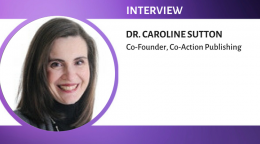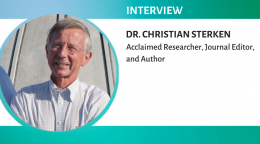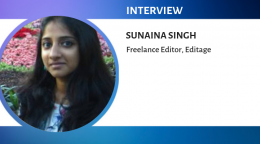Peer review-worthy papers, journal decision making, and more...
Interview with Dr. Helle Goldman
Denmark-born, American anthropologist Helle V. Goldman is the Chief Editor of Polar Research, the international, multi-disciplinary, peer-reviewed journal of the Norwegian Polar Institute (NPI). She has been at the NPI, part of the Ministry of Climate and Environment, for 16 years. She holds an MA (1990) and PhD (1996), based on fieldwork in Zanzibar, in social anthropology from New York University. In this interview series, Dr. Goldman shares the importance of polar science as a research discipline and as an area of global development. She also highlights the international differences between authors and provides useful tips for researchers on journal selection and manuscript submission.

Denmark-born, American anthropologist Helle V. Goldman is the Chief Editor of Polar Research, the international, multi-disciplinary, peer-reviewed journal of the Norwegian Polar Institute (NPI). She has been at the NPI, part of the Ministry of Climate and Environment, for 16 years. She holds an MA (1990) and PhD (1996), based on fieldwork in Zanzibar, in social anthropology from New York University. In her free time Dr. Goldman visits Botswana, where her family has a few hectares of wilderness on the edge of the Okavango Delta. She also edits works of fiction and translates books from Norwegian to English, including Norway in the Antarctic: from conquest to modern science (by J.-G. Winther et al., published by Schibsted in 2008). She lives above the Arctic Circle, in Tromsø. (Many of her publications are available upon request. Picture of Goldman by the courtesy of Ann Kristin Balto, NPI.)
Are you closely involved in the decisions at your journal to accept/reject papers?
As Polar Research’s Chief Editor – a position I’ve held since 1998 – I make the final decisions on all submissions and I compose and send the decision “letters” (e-mails). For manuscripts that are handled by one of the journal’s highly capable Subject Editors, I follow their recommendations. If I have a difference of opinion, it’s usually over something like whether we never want to see the paper in question again or whether we might be willing to give the authors a chance to resubmit it. In cases like this, the SE and I discuss the matter and arrive at a decision together. It goes very smoothly.
Can you give us some clues as to what makes you decide that papers are not even worth sending for peer review or worth read beyond title or cover letter (apart from the reason that they don’t fit the journal scope and aim)?
A couple of years ago we started routinely running new submissions through CrossCheck to identify passages lifted from published papers by the same or other authors. A limited amount of self-plagiarism in the methods section is tolerable, but if it exceeds that then the manuscript doesn’t go out for review. Depending on the scale and nature of the plagiarism, the author may be given a chance to rewrite and resubmit or the paper may be rejected outright.
We also check the abstracts before sending papers out for review. If the abstract is inadequate, the paper goes back to the author with instructions for a better abstract.
If a paper seems to have no basis in original research, and is neither a review paper nor an “opinion” piece presenting some new connections or ideas but solidly rooted in widely accepted scientific principles, then we don’t consider it.
How do you decide whether a paper is novel enough or significant enough?
Formerly, novelty wasn’t a decisive factor for Polar Research: if the science was good (sound methods, appropriate analysis, well-grounded interpretations and conclusions) and the paper contributed to the corpus of scientific knowledge about a topic within the scope of the journal, then we would do our best to work with the author to bring the presentation (the writing, structure, graphics, etc.) up to a good standard so we could publish the paper. Our philosophy was that a paper might not be the sexiest article in the world but if the data and interpretations were sound and potentially of interest to other researchers or environmental managers then they deserved to be available – in a polished, peer-reviewed format – for others to build on.
As our submission rate has been climbing we’re having to rethink this a bit and to give more weight to questions of novelty and originality. With a limited budget, we can only publish a certain number of pages per year. This means that as submissions go up, we have to reject a greater proportion of them.
To what extent do you rely on peer reviewers to make accept/reject decisions?
Polar Research’s SEs and I rely very heavily on reviewers for their expert opinions. However, when it comes to rendering a decision on a manuscript, it’s not usually a matter of simply rubber-stamping the reviewers’ recommendations. Reviewers often have contrasting opinions. It’s rare for one reviewer to love a paper and another to hate it, but it happens. More often the differences are less dramatic but are nonetheless important. For example, Reviewer A thinks the analysis was just fine while Reviewer B believes the analysis wasn’t well-suited to the data and the research questions and this reviewer maintains that different analytical tools should be applied before the paper can be considered publishable. We have to decide which review “counts” more. At this stage, it can be helpful to take another look at the profiles of the reviewers – their areas of expertise, their publication records and so on. The reviews as a whole should also be examined again: is one review generally more thorough and thoughtful than the other one? Are there signs that Reviewer A just didn’t give enough time to the review to discover the problems identified by Reviewer B? These considerations sometimes allow an editor to give different weights to the two reviews. It may be necessary to call in an additional reviewer with special competence to comment specifically on the aspect of the paper that the current reviewers disagree on. Unfortunately, this adds time to the review process, but if the SEs and I lack the expertise needed to assess the problem there’s just no way to get around it.
What is the average review time from submission to acceptance?
Ah, yes, that’s what potential contributors always want to know. It’s roughly two or three months from initial submission to first decision. The timespan between first decision through subsequent rounds of revision and re-review and, finally, publication, is highly variable and is to a large extent dependent on how fast the authors work to revise their work. An author can sit on a revision for six months or more, and sometimes a paper goes through three or four rounds of revision and review. We give reviewers four weeks to submit their reviews once they’ve agreed to do the job, but it can take several weeks to find willing/able reviewers in the first place. Finding reviewers is the most time-consuming and challenging part of what we editors do at Polar Research. We commonly have to contact eight or ten reviewers before we get two or three positive responses. In one recent case I had to invite 20 people before I got two “yeses.” And then they’re frequently late in delivering their reports.
Chasing down late reviews is my least favourite part of the job and I daresay this goes for our SEs too. We’re grateful that the reviewers have agreed to evaluate manuscripts intended for Polar Research. This is certainly not paid work. They will receive little or no credit for it and it takes time away from their many other important professional activities (including writing and publishing their own papers) and may well cut into their free time. We know that our reviewers are mostly very busy people who are perhaps overextended and who don’t intend to inconvenience anyone. It’s no fun sending them increasingly crabby e-mails in order to extract reviews from them. Sometimes the reviewers just never deliver and we have to seek new reviewers, further dragging out the process and trying the patience of the authors.
The authors expect to receive a decision – based on a thorough and fair review – within a couple of months. Indeed, an “accept” decision on a particular paper may be a crucial component in a researcher’s bid for a job or an application for funding. I’m probably not the only editor who wishes that when a scientist is asked to review a paper, she agrees only if she’s confident she can deliver a thorough and constructive critique within the given timeframe. I always appreciate it when a reviewer says, up front, that the paper is right up his alley and he’s keen to review it, but he’ll need two extra weeks or whatever he requires. I’m usually happy to grant that extension, and the fact that the reviewer has given some thought to when he is going to be able to complete the review means that there’s a good chance he’ll deliver it by the agreed-upon date, so I won’t have to waste my time (or his) with nagging e-mails.
Read the second part of this three-part interview series in which Dr. Goldman provides advice to authors on how to select journals to publish in.
.
Published on: Mar 29, 2014
Comments
You're looking to give wings to your academic career and publication journey. We like that!
Why don't we give you complete access! Create a free account and get unlimited access to all resources & a vibrant researcher community.













